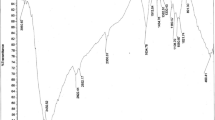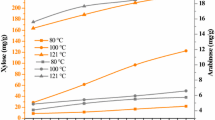Abstract
Enzymatic hydrolysis of pretreated lignocellulosic raw material is one of the major steps in the biofuel production. In this study, sorghum straw was pretreated under previously optimized conditions (using 0.5 M sodium hydroxide, 8% substrate concentration, 120 °C temperature and 20 min of incubation time). Cellulase enzymes were produced using three different fungal sources (Aspergillus niger, Fusarium oxysporum and Trichoderma harzianum). Enzymatic hydrolysis of pretreated biomass was carried out using individual and different mixture of cellulases. Maximum reducing sugar yield was obtained when an equal mixture of three different cellulases was used. The enzymatic hydrolysis process was optimized through central composite design based on response surface methodology using an equal mixture of three different cellulases (1:1:1). The data showed that maximum reducing sugar yield of 464.2 mg/g dry substrate was obtained at 10% substrate concentration, 55 °C and after 48 h of incubation. Further, batch (a process where all the substrates were fed into the bioreactor at the beginning of the reaction) and fed-batch (a process where substrates were fed into the bioreactor at specific time intervals) process of enzymatic hydrolysis were compared at high substrate concentration (20%). The results showed that an increase in reducing sugar yield (355.6 mg/g dry substrate) was obtained in case of fed-batch enzymatic hydrolysis as compared to batch enzymatic hydrolysis (285.3 mg/g dry substrate) process. The above results can be useful for efficient hydrolysis of lignocellulosic biomass and cost-effective biofuel production.




Similar content being viewed by others
References
Adsul M, Sharma B, Singhania RR, Saini JK, Sharma A, Mathur A, Gupta R, Tuli DK (2014) Blending of cellulolytic enzyme preparations from different fungal sources for improved cellulose hydrolysis by increasing synergism. RSC Adv 4:44726–44732
Anjum MF, Tasadduq I, Al-Sultan K (1997) Response surface methodology: a neural network approach. Eur J Oper Res 101:65–73
Badhan A, Wang Y, Gruninger R, Patton D, Powlowski J, Tsang A, McAllister T (2014) Formulation of enzyme blends to maximize the hydrolysis of alkaline peroxide pretreated alfalfa hay and barley straw by rumen enzymes and commercial cellulases. BMC Biotechnol 14:1–14
Cai D, Li P, Luo Z, Qin P, Chen C, Wang Y, Wang Z, Tan T (2016) Effect of dilute alkaline pretreatment on the conversion of different parts of corn stalk to fermentable sugars and its application in acetone–butanol–ethanol fermentation. Bioresour Technol 211:117–124
Canilha L, Chandel AK, Milessi TSS, Antunes FAF, Freitas WLC, Felipe MGA, Silva SS (2012) Bioconversion of sugarcane biomass into ethanol: an overview about composition, pretreatment methods, detoxification of hydrolysates, enzymatic saccharification, and ethanol fermentation. J Biomed Biotechnol 2012:1–15
Chen Y, Stevens MA, Zhu Y, Holmes J, Xu H (2013) Understanding of alkaline pretreatment parameters for corn stover enzymatic saccharification. Biotechnol Biofuel 6:8
Cotana F, Barbanera M, Foschini D, Lascaro E, Buratti C (2015) Preliminary optimization of alkaline pretreatment for ethanol production from vineyard pruning. Energy Proc 82:389–394
Fakhriyan G, Mousavi HZ, Sajjadi SM (2016) Speciation and determination of Cr(III) and Cr(VI) by directly suspended droplet microextraction coupled with flame atomic absorption spectrometry: an application of central composite design strategy as an experimental design tool. Anal Methods 8:5070–5078
Ge X, Burner DM, Xu J, Phillips GC, Sivakumar G (2011) Bioethanol production from dedicated energy crops and residues in Arkansas, USA. Biotechnol J 6:66–73
Gupta R, Kumar S, Gomes J, Kuhad RC (2012) Kinetic study of batch and fed-batch enzymatic saccharification of pretreated substrate and subsequent fermentation to ethanol. Biotechnol Biofuel 5:1–10
Jeya M, Zhang YW, Kim IW, Lee JK (2009) Enhanced saccharification of alkali-treated rice straw by cellulase from Trametes hirsuta and statistical optimization of hydrolysis conditions by RSM. Bioresour Technol 100:5155–5161
Karapatsia A, Pappas I, Penloglou G, Kotrotsiou O, Kiparissides C (2016) Optimization of dilute acid pretreatment and enzymatic hydrolysis of Phalaris aquatica L. lignocellulosic biomass in batch and fed-batch processes. Bioenerg Res. doi:10.1007/s12155-016-9793-4
Keharom S, Mahachai R, Chanthai S (2016) The optimization study of α-amylase activity based on central composite design-response surface methodology by dinitrosalicylic acid method. Int Food Res J 23:10–17
Klein-Marcuschamer D, Oleskowicz-Popiel P, Simmons BA, Blanch HW (2012) The challenge of enzyme cost in the production of lignocellulosic biofuels. Biotechnol Bioenerg 109:1083–1087
Kristensen JB, Felby C, Jørgensen H (2009) Yield-determining factors in high-solids enzymatic hydrolysis of lignocelluloses. Biotechnol Biofuels 2:11
Kuila A, Mukhopadhyay M, Tuli DK, Banerjee R (2011) Production of ethanol from lignocellulosics: an enzymatic venture. EXCLI J 10:85–96
Kumar P, Barrett DM, Delwiche MJ, Stroeve P (2009) Methods for pretreatment of lignocellulosic biomass for efficient hydrolysis and biofuel production. Ind Eng Chem Res 48:3713–3729
Li C, Lin F, Li Y, Wei W, Wang H, Qin L, Zhou Z, Li B, Wu F, Chen Z (2016a) A β-glucosidase hyper-production Trichoderma reesei mutant reveals a potential role of cel3D in cellulase production. Microb Cell Fact 15:151
Li Y, Liu C, Bai F, Zhao X (2016b) Overproduction of cellulase by Trichoderma reesei RUT C30 through batch-feeding of synthesized low-cost sugar mixture. Bioresour Technol 216:503–510
Liguori R, Ionata E, Marcolongo L, Vandenberghe LPS, Cara FL, Faraco V (2015) Optimization of Arundo donax saccharification by (hemi)cellulolytic enzymes from Pleurotus ostreatus. Biomed Res Int 2015:1–14
Lü JL, Zhao PJ (2011) Optimal conditions for maximizing production of reducing sugars from microwave-assisted FeCl3 pretreated rice straw degraded by Trichoderma viride and Bacillus pumilus. Afr J Microbiol Res 5:5757–5764
Miller GL (1959) Use of dinitrosalicylic acid reagent for determination of reducing sugar. Anal Chem 31:426–428
Mkhize T, Mthembu LD, Gupta R, Kaur A, Kuhad RC, Reddy P, Deenadayalu N (2016) Enzymatic saccharification of acid/alkali pre-treated, mill-run, and depithed sugarcane bagasse. Bioresour 11:6267–6285
Mohanram S, Amat D, Choudhary J, Arora A, Nain L (2013) Novel perspectives for evolving enzyme cocktails for lignocellulose hydrolysis in biorefineries. Sustain Chem Process 1:15
Myers RH, Montgomery DC (1995) Response surface methodology: process and product optimization using designed experiments. Wiley, New York
Nathan VK, Rani ME, Rathinasamy G, Dhiraviam KN, Jayavel S (2014) Process optimization and production kinetics for cellulase production by Trichoderma viride VKF3. SpringerPlus 3:1–12
Pandiyan K, Tiwari R, Rana S, Arora A, Singh S, Saxena AK, Nain L (2014) Comparative efficiency of different pretreatment methods on enzymatic digestibility of Parthenium sp. World J Microbiol Biotechnol 30:55–64
Saha BC, Cotta MA (2008) Lime pretreatment, enzymatic saccharification and fermentation of rice hulls to ethanol. Biomass Bioenerg 32:971–977
Saini JK, Adsul M, Singhania RR, Satlewal A, Saini R, Gupta R, Mathur A, Tuli DK (2016) Improvement of wheat straw hydrolysis by Cellulolytic blends of two Penicillium spp. Renew Energy 98:43–50
Sharma S, Sharma V, Kuila A (2016) Cellulase production using natural medium and its application on enzymatic hydrolysis of thermo chemically pretreated biomass. 3 Biotech 6:1–11
Sindhu R, Binod P, Pandey A (2016) Biological pretreatment of lignocellulosic biomass—an overview. Bioresour Technol 199:76–82
Taherzadeh M, Karimi K (2008) Pretreatment of lignocellulosic wastes to improve ethanol and biogas production: a review. Int J Mol Sci 9:1621–1651
Takimura O, Yanagida T, Fujimoto S, Minowa T (2013) Estimation of bioethanol production cost from rice straw by on-site enzyme production. J JPA Pet Inst 56:150–155
Vintila T, Dragomirescu M, Croitoriu V, Vintila C, Barbu H, Sand C (2010) Saccharification of lignocellulose—with reference to Miscanthus—using different cellulases. Rom Biotech Lett 15:5498–5504
Xu G, Liang C, HuangP Liu Q, Xu Y, Ding C, Li T (2016) Optimization of rice lipid production from ultrasound-assisted extraction by response surface methodology. J Cereal Sci 70:23–28
Yang H, Yan R, Chen H, Zheng C, Lee DH, Liang DT (2006) In-depth investigation of biomass pyrolysis based on the three major components: hemicellulose, cellulose and lignin. Energy Fuel 20:388–393
Acknowledgements
Authors are thankful to Prof. Aditya Shastri, Vice Chancellor, Banasthali University, for research facilities and infrastructure.
Funding
This work was not supported by any funding authority. It was carried out by our own interest.
Author information
Authors and Affiliations
Corresponding author
Ethics declarations
Conflict of interest
The authors declare that they do not have any conflict of interest in the publication.
Rights and permissions
About this article
Cite this article
Sharma, S., Kuila, A. & Sharma, V. Enzymatic hydrolysis of thermochemically pretreated biomass using a mixture of cellulolytic enzymes produced from different fungal sources. Clean Techn Environ Policy 19, 1577–1584 (2017). https://doi.org/10.1007/s10098-017-1346-9
Received:
Accepted:
Published:
Issue Date:
DOI: https://doi.org/10.1007/s10098-017-1346-9




